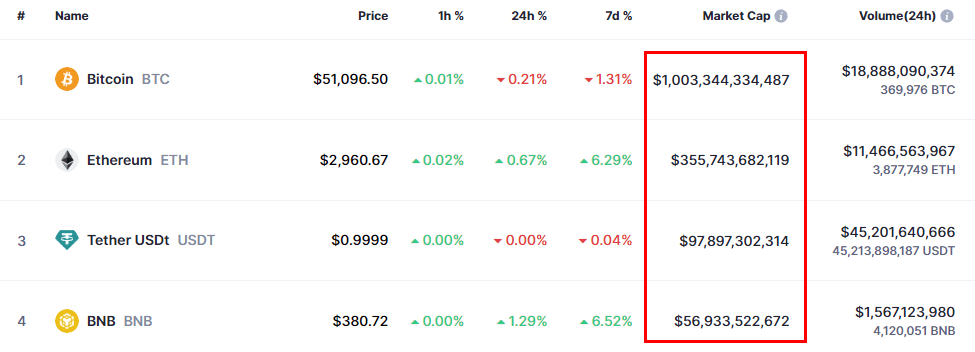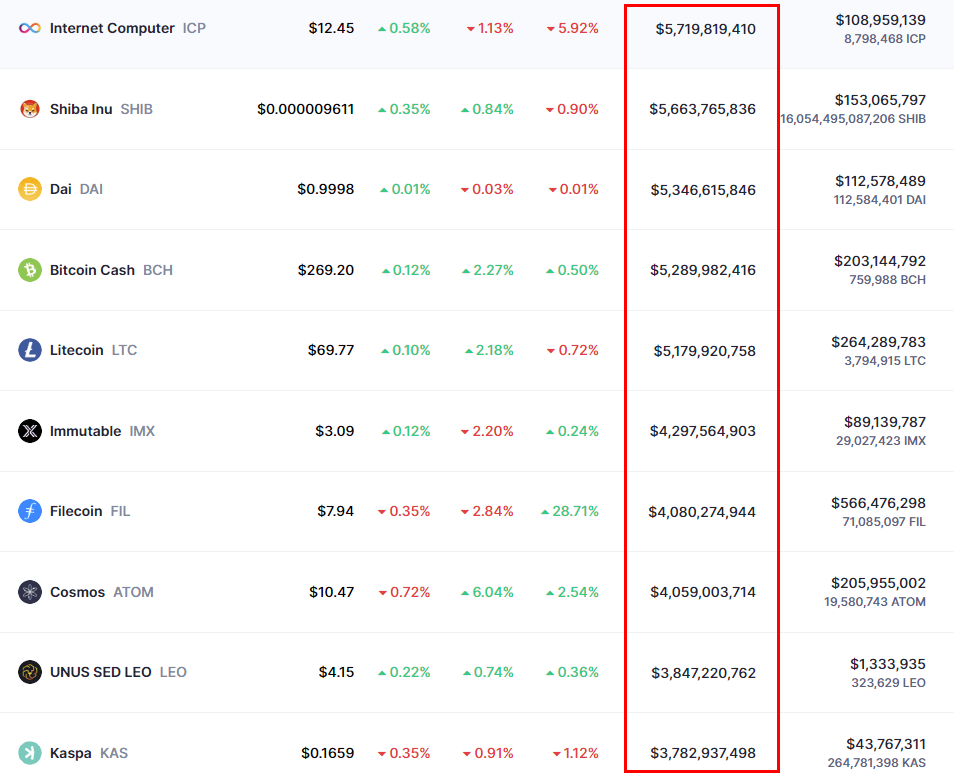What are Large cap, Mid cap and Small cap coins / tokens in cryptocurrency?
Cap is an informal term for market capitalization. Market cap is a metric used to measure the real market value of a cryptocurrency and is usually classified into three types such as: Large cap, mid cap and small cap. All of the coins and tokens that you find in CoinMarketCap & Coingecko website falls under either of these three categories. It is the indicator that shows the dominance and popularity of a cryptocurrency.
To have a better understanding of large cap, mid cap and small cap we first suggest you to read this post that explains market cap, supply and volume. Also know the difference between circulating, total and max supply of a cryptocurrency which also relates to this post.
If you cannot find a market cap of a coin or wondering how market cap is calculated then you can simply use our market cap calculator tool which explains everything in detail.
Alright! Now let’s understand the difference between large-cap vs mid-cap vs small-cap. Here we’ll not be listing any coins or tokens and is not any kind of investment advice. Instead this post will give you an idea of what large cap, mid cap and small cap coins are and their risk / rewards.
What does Large cap, Mid cap and Small cap mean in cryptocurrency?
High market cap, mid market cap and small market cap is not only a metric used to classify cryptocurrencies. But is also a common term widely used in stock markets.
In stock market the difference between large cap and small cap is like comparing Apple, Microsoft, Tesla stocks to penny stocks. Likewise in crypto it is like comparing Bitcoin to some newly launched altcoin.
So how are coins divided as large cap coin, mid cap coin and small cap coin?
Large Cap
Large cap cryptocurrencies are coins that have a market capitalization more than $50 Billion USD. With that estimate if we look at the current market we only have four currencies that are classified as large-cap. As of writing this article we only have Bitcoin, Ethereum, USDT (stable coin) and BNB. These projects have a long term proven track record, strong security and they are the major players in the cryptocurrency space.

Mid Cap
Mid cap coins and tokens generally have a market capitalization anywhere between $10 Billion USD to $50 Billion USD. These projects are well established, expanding and may expected to experience rapid growth in the near future. Some of the popular coins and tokens that fall under this category are Solana, Cardano, Chainlink, Polkadot, Avalanche, Tron, Polygon and there are few others.

Small Cap
Coins and tokens that have a market cap less than $10 Billion USD and more than 500 Million USD can be classified into small caps. Some of the coins in this list are well established and have long track record however they no longer perform well and does not provide much value to the ecosystem.
On the other hand there are projects that don’t have much track record and they don’t have much resources compared to top projects. Due to their age and size they carry higher risk than large and mid cap coins. Most of the low cap coins tend to fail but at the same time if researched properly you can find a gem with great growth potential especially during the bull markets.

Micro cap
Followed by small cap we also have micro cap coins which are more riskier than small cap coins. Consider it as a penny stock. A coin or token launched by some anonymous group or person and have a value less than $500 million in market cap.
So what do they all mean?
High-caps vs mid-caps vs small-caps
By ranking coins based on market cap we are basically categorizing crypto projects based on popularity and risk factor. It shows how much risk we are basically dealing when investing in a cryptocurrency. The underlying factor involved in this are projects strength, core values, volatility, liquidity and responsiveness.
So which of these three categories is riskier, which one is very volatile, which one lacks liquidity and which ones are more responsive?
Large-caps: High liquidity, less volatile and low risk
First of all crypto in general is an speculative asset class and so risk only what you can afford to lose. With that said large cap cryptocurrencies are the least risky ones of all three categories.
Investing in large caps won’t yield you quick significant gains but slow conservative growth.
Coins that fall under these category have high liquidity. It means you can find these coins on almost every cryptocurrency exchanges and they have high trading volume. With high liquidity it gets easy for an investor to get in and get out. One can place a huge buy or sell order and get the order filled immediately.
Large caps are less volatile meaning it is harder to move the price in either direction compared to low and mid caps. But still they are more volatile compared to traditional assets like stocks.
Mid-caps: Medium risk, good liquidity and great growth potential
Mid cap crypto’s are more volatile and carry higher risk than large caps. These coins are not as established as large caps. The coins in mid caps are still in the phase of increasing their utility and many of it has not reached its full potential yet. Due to this they have higher growth potential compared to large cap coins.
In general mid cap cryptocurrencies tend to perform well in the long run and having them in your portfolio is good diversification measure. However remember that not all coins have the potential to transform into large caps.
Low-caps:- High risk, high volatility and lacks liquidity
Volatility of a cryptocurrency is one of the main factor that determines risk. With that said, a coin with small market cap is likely to experience more volatility than a coin with higher market cap. This is because small market cap are more susceptible to price fluctuations. A single massive buy or sell order can move the price rapidly. Due to rise and fall of prices sharply in a short period of time your investment in this instrument is highly risky.
Small caps are also more sensitive to market sentiments. Since these coins are mostly new and do not have much history a single positive or negative note on media can make or break the coin easily.
Another problem with low caps is that they are less liquid. Meaning you cannot usually find these coins on major exchanges. Some of them are only available on DEX (decentralized exchange). Due to lack of exchange and trading volume it’s hard to buy or liquidate huge amounts of low cap coins.
Market caps: Summary
High-capitalization: With large cap crypto’s your investment will experience minimal but steady growth. Also coins in this category are more safer than the others.
Mid-capitalization: Mid cap coins and tokens are quite interesting. This segment offers great growth opportunities with controlled risk.
Small-capitalization: Small cap projects have the potential to truly explode in value and give you massive gains. But that applies to only less than 1% of all the coins in this category.
So which cap should you invest in?
Diversify your crypto portfolio
All coins and tokens are not the same. Every project have different features and most of them are designed to solve specific use cases. Also all these three market cap classes do not experience same growth rate and their risk reward ratio also greatly differs. So when investing it is better to diversify your portfolio and have a right mix of all three classes.
The main advantage of diversification is 1. risk reduction and 2. reaping the best from the cryptocurrency ecosystem.
But if you are taking crypto seriously then it is recommended that more than 70% of your investment should be held on large caps. This is what most safe investors prefer.
Start with coins such as Bitcoin and Ethereum. Learn this space, read a lot, do more research and then move on to promising mid caps like Solana, Cardano, Polygon etc.
Cap size is not the only essential metric
When investing in cryptocurrency picking coins based on cap size shouldn’t be your only priority. Market cap is a great metric to evaluate the popularity and dominance of a cryptocurrency. But that is not the only metric. There are other factors you should consider when choosing a cryptocurrency such as: the projects core team, fundamentals, technical and value proposition.
Then there is also something called coin / token supply which greatly affects the market cap. Most centralized projects have the power to burn coins and manipulate coin supply specifications to climb the cmc rankings.
As an investor you should thoroughly research the project before buying the crypto. Check the projects track record. Also keep a look at the daily traded volume as most of the coins in small and micro caps are highly manipulated.
Finally if you ever come across an YouTube video or Twitter profile promoting coins with big moon shot promises do not fall for it. This is all a speculative asset class so make your make your own investment decisions and invest at your own risk.




